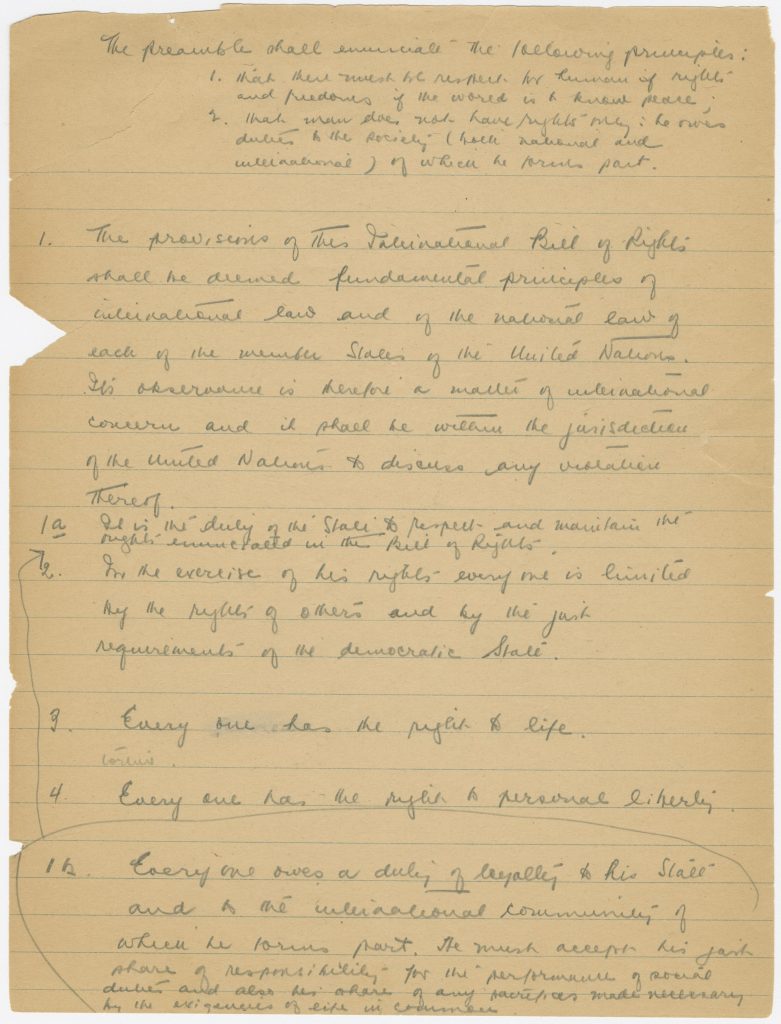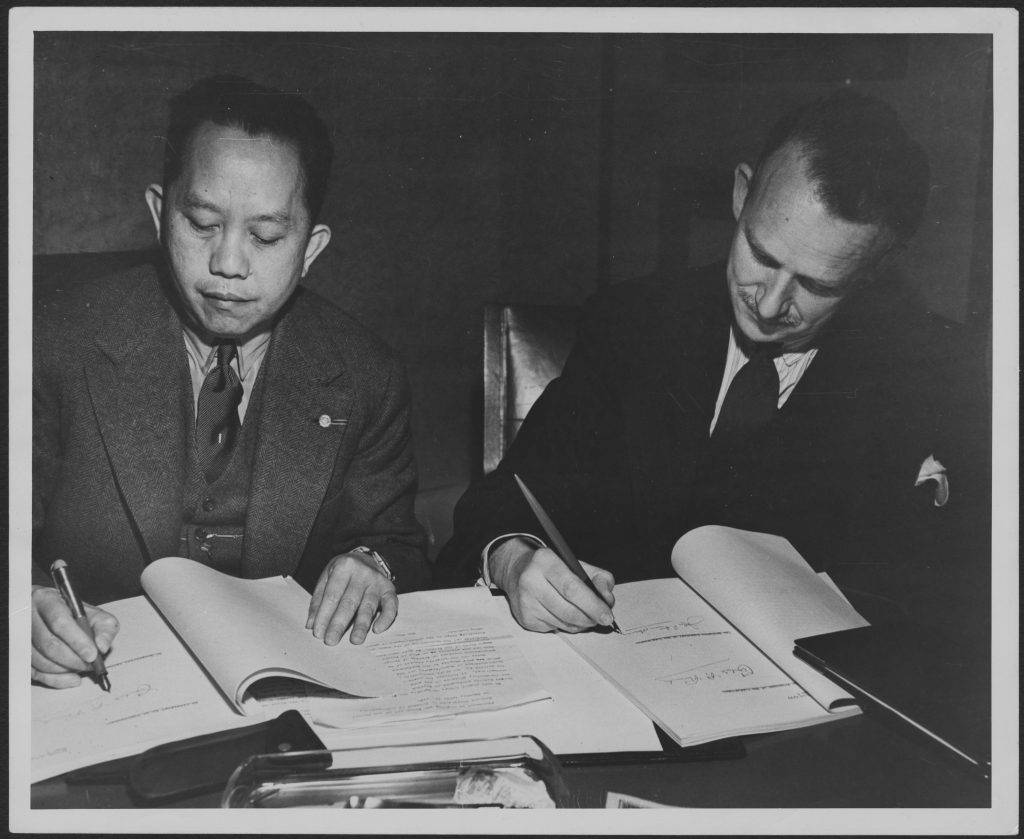by Ana Rogers-Butterworth, Liaison Librarian, Nahum Gelber Law Library
Commemorating the 75th anniversary of the Universal Declaration of Human Rights (UDHR), the newest exhibit at the Nahum Gelber Law Library offers a captivating exploration of human rights and its impact on Canada.

Step into the Nahum Gelber Law Library and delve into a captivating exploration to commemorate the 75th anniversary of the Universal Declaration of Human Rights (UDHR) and its profound impact on Canada. Beginning December 10th, this immersive exhibit will provide a unique opportunity to explore the history of human rights through the remarkable life and contributions of John Humphrey, a visionary former McGill professor who played a pivotal role in drafting the original UDHR. Humphrey’s fonds is now held at the McGill University Archives, and includes personal artifacts from Humphrey’s life, including his travel documents, medals, and photographs. A focal point of the exhibit is a facsimile of the UDHR, allowing visitors to delve into Humphrey’s handwritten notes and gain a deeper understanding of the thought processes that went into crafting this historic document.
The exhibit draws from Humphrey’s fonds and McGill’s rare and archival collections to spotlight key articles of the UDHR, providing a nuanced exploration of their impact on Canadian society. In the realm of education, tangible reminders of the journey towards universal education rights include Humphrey’s own educational materials, alongside other items from the McGill collection such as diplomas, yearbooks, and commencement memorabilia. Additionally, the exhibit features photographs highlighting significant milestones, such as the graduation of the first female Law student, reflecting the evolving landscape of educational inclusivity.


(no case blue fabric) Medal of Honour of the United Nations Association in Canada.
(left) Order of Canada/Ordre National du Québec lapel pins
Marriage rights take center stage as the exhibit chronicles the transformation of societal perspectives, particularly in the context of same-sex marriage. The material on display will underscore the progress made and the ongoing commitment to fostering inclusivity and equality within Canadian society.
Delving into economic rights, the exhibit will explore the theme of fair wages, drawing on both recent strikes and historical perspectives. By examining the struggles and triumphs in this area, visitors gain insight into the continuous pursuit of economic justice in Canada.
Religious diversity and its role in shaping Canadian society are illuminated in the exhibit. It will not only showcase the richness of religious traditions but also delve into protests related to Bill 21 in Quebec, underlining the intersection of human rights and societal discourse.
A critical section of the exhibit will serve as a stark reminder of the challenges that persist, emphasizing the long road ahead for reconciliation. Addressing issues such as residential schools, the Truth and Reconciliation report, Indigenous memoirs, and reflections on the Oka crisis, this segment prompts visitors to confront the complexities of Canada’s history and the ongoing work required for authentic implementation of Humphry’s ideals.
Woven throughout the exhibit is an overarching theme: the right to peaceful protest. This resonant theme captures the spirit of activism embraced by Montrealers and Canadians alike. To visually represent this theme, the exhibit draws from the poster archive run by the Quebec Public Interest Research Group at Concordia, showcasing the power of advocacy and collective action in shaping societal change.
As visitors engage with the exhibit, they will be invited to reflect not only on the progress made but also on the challenges that lie ahead. The narrative that unfolds underscores the enduring spirit of change that defines Canada’s commitment to human rights. By celebrating the contributions of John Humphrey and examining the multifaceted legacy of the UDHR, the exhibit encourages thoughtful consideration of the past, present, and future of human rights in Canada.
The Humphrey’s fond has recently been added to the Canadian Memory of the World Register, maintained by Canadian Commission for UNESCO. The fonds is now recognized as an important piece of Canadian’s collective history, for Humphrey’s role in crafting and contributing to the Universal Declaration of Human Rights.
Au-delà de l’énoncé : Point de vue canadien sur la Déclaration universelle des droits de l’homme
by Ana Rogers-Butterworth, Bibliothécaire de liaison, Bibliothèque de Droit Nahum Gelber
À l’occasion du 75e anniversaire de la Déclaration universelle des droits de l’homme (DUDH), une exposition à la Bibliothèque de droit Nahum Gelber est consacrée à son histoire et à ses retombées au Canada.

Rendez-vous à la Bibliothèque de droit Nahum Gelber pour découvrir la constitution et les profondes retombées au Canada de la Déclaration universelle des droits de l’homme (DUDH), à l’occasion de son 75e anniversaire. Dès le 10 décembre, cette exposition immersive vous plongera dans l’histoire des droits de la personne à travers la vie de John Humphrey, un visionnaire et ancien professeur de McGill, qui a joué un rôle déterminant dans l’ébauche du texte original de la DUDH. Les Archives de McGill détiennent le fonds et des artéfacts personnels de John Humphrey, comme des documents de voyage, des médailles et des photographies. L’une des pièces maîtresses de l’exposition, un fac-similé de la DUDH, montre les notes manuscrites du professeur, donnant un aperçu du processus intellectuel à l’œuvre lors de la rédaction de ce document historique.
Puisant dans le fonds de John Humphrey et dans les livres rares et les archives de McGill, l’exposition met en évidence certains articles de la DUDH en offrant une vision nuancée de leurs répercussions sur la société canadienne. Le matériel pédagogique du professeur Humphrey et d’autres éléments du fonds de McGill, comme des diplômes, des albums de fin d’études et des souvenirs de collation des grades, rappellent la lutte menée pour le droit universel à l’éducation. On peut aussi y voir des photographies illustrant des faits historiques importants, comme la remise du diplôme à la première étudiante en droit, qui témoignent de l’évolution vers un système d’éducation plus inclusif.


L’exposition présente également une chronologie de l’évolution des mœurs sociétales relatives au mariage, en particulier entre personnes de même sexe. Elle souligne les progrès accomplis en matière d’inclusion et d’équité dans la société canadienne, ainsi que l’engagement continu à poursuivre ces objectifs.
Le thème de l’équité salariale est également abordé, s’appuyant sur les récents mouvements de grève et sur une perspective historique des droits économiques. La poursuite d’une justice socioéconomique au pays est jalonnée de luttes et de victoires, qui sont mises en relief ici.
Il est aussi question de l’influence de la diversité religieuse sur la société. L’exposition s’intéresse non seulement la richesse des différentes traditions, mais aussi à la vague de contestation soulevée par le projet de loi 21 au Québec, qui révèle les liens entre les droits de la personne et le discours sociétal.
Une importante section consacrée à la réconciliation rappelle avec force la persistance d’inégalités et la longue route qu’il reste à parcourir pour y parvenir. En se basant sur les pensionnats, le rapport de la Commission de vérité et réconciliation, les mémoires autochtones et la crise d’Oka, l’exposition montre toute la complexité de l’histoire du Canada et la voie à suivre pour réaliser les idéaux du professeur Humphrey.
Un thème général domine l’ensemble de l’exposition, celui du droit à la manifestation pacifique, qui rend hommage au militantisme des populations de Montréal et du Canada. Le thème se traduit visuellement par les affiches d’archives du Groupe de recherche d’intérêt public du Québec de l’Université Concordia, témoins du pouvoir de l’action collective pour opérer un changement sociétal.
L’exposition invite à la réflexion à la fois sur les progrès accomplis et sur les défis qu’il nous reste à relever. Elle est le reflet de l’esprit progressiste qui sous-tend l’engagement du Canada à défendre les droits de la personne. En célébrant le travail de John Humphrey et l’héritage de la DUDH, elle jette un regard éclairé sur les droits de la personne dans le passé, aujourd’hui et à l’avenir.
Le fonds John Humphrey a récemment été inscrit au Registre de la mémoire du monde du Canada, tenu par la Commission canadienne pour l’UNESCO (CCUNESCO). Il est reconnu comme un élément important de l’histoire collective du Canada pour l’apport du professeur Humphrey à l’ébauche de la Déclaration universelle des droits de l’homme.













Leave a Reply
You must be logged in to post a comment.